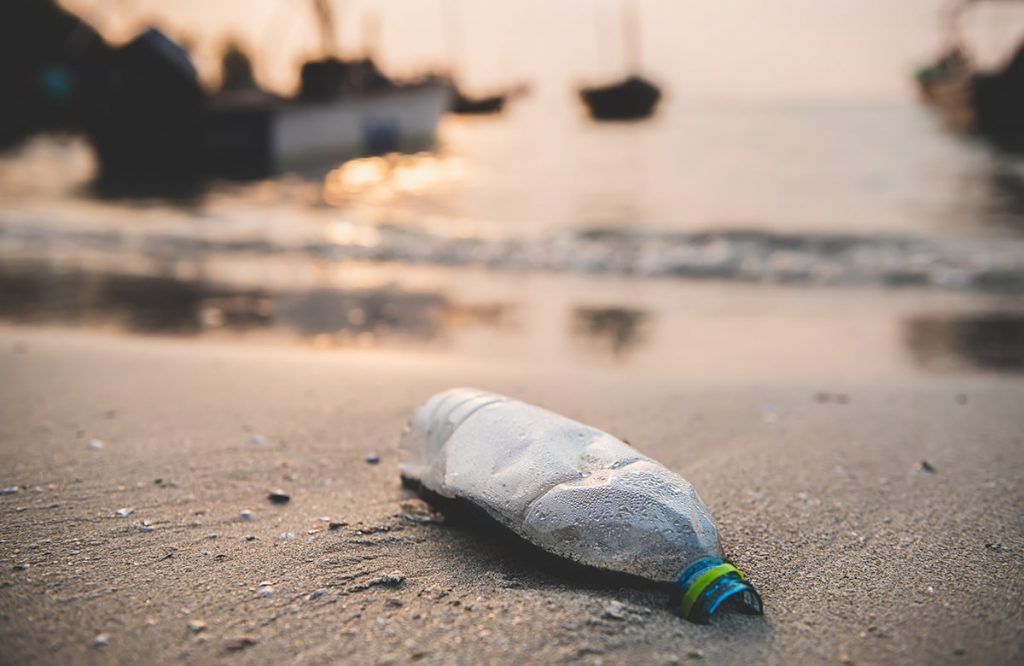Plastic is everywhere. From soda bottles to cars, packaging to electronics, fishing gear to clothing and everything in between, it’s not surprising that such a widely used substance has environmental consequences. Though plastic has many advantages in the right situation, it’s simply been used too much. Here are 5 ways that plastic harms the environment, and 5 reasons to reduce plastic waste as much as possible. We’ve updated this blog post in 2023 to include a few solutions to the plastic waste problem, too.
5 Ways Plastic Harms the Environment
1. Kills Ocean Life
By now you’ve probably heard about the mass amounts of plastic polluting oceans and other waterways. Plastic debris makes its way into oceans from rivers, shorelines, or boats. This plastic debris affects all kinds of ocean life, from sea turtles to ocean birds to sharks to fish and everything in between. Animals get tangled or stuck in discarded nets or bottles, choke on plastic debris, fill their stomachs with plastic they mistake for food, and much more. As these animals die, the ecosystems they play an essential part in begin to die with them.
Besides killing marine animals, plastic pollution also harms the environment by destroying habitats. You may have heard of the ocean garbage patches, huge collections of plastic thousands of miles across containing literal tons of plastic. These areas contain solid plastic debris as well as tiny microplastic beads, kept in place by ocean currents. These areas are uninhabitable and uncrossable by most animals, and they now cover huge swathes of the ocean.
As ocean ecosystems die, the effects don’t stop at the ocean itself. This also creates catastrophes for humanity, including starvation, overheating, widespread land erosion, and more.
Twice the Ice Refillable Water and Ice Stations Divert an Average of 250,000 Plastic Bottles per Location—approximately 500 million bottles a year network-wide
2. Kills Terrestrial Wildlife
Plastic also harms the environment by killing land animals. Just like their water-dwelling counterparts, land animals haven’t evolved to deal with ocean pollution. They get tangled and choked in many of the same ways as ocean animals. Once again, this creates a ripple effect within ecosystems, which depend on every participant, from plants to bugs to apex predators to thrive. As their numbers decrease, the ecosystem weakens and shrinks.
Though the effects of plastic on plant life are still being studied, early experiments show that plastic negatively affects plant growth. This not only affects the ecosystems around us, which store carbon and provide oxygen, but also affects our own ability to grow food and feed livestock.
3. Takes Up Space
Keeping plastic debris contained is a difficult task, especially when dealing with the sheer amount of plastic waste produced daily. Around the world, humans produce 380 million tons of plastic waste annually. That number is hard to even imagine; it’s about 95 tons of plastic spread over every square mile of the United States.
The weight of plastic is only a fraction of the problem. Most plastic waste is lightweight, but takes up space, so the volume or the space that plastic waste takes up is a bigger problem. Most people don’t want to live close to landfills, so finding space for plastic waste often means moving it far away and making surrounding wildlife habitats even smaller. This is another way that plastic harms the environment.
Recycling seems like a solution to this problem. However, 90% of plastic waste is either buried or burned. Deceptive campaigns by plastic producers led consumers to believe that plastic could be effectively recycled, when it isn’t realistic. It’s much more expensive to recycle plastic, the options for using recycled plastic are slim, and it can’t be reused more than once or twice. The best option is simply not to use plastic that will end up as trash.
4. Produces Chemical Pollution
Plastic also harms the environment through pollution. Plastics are essentially made from oil and gas. Mining these nonrenewable resources produces harmful chemicals like benzene, toluene, ethylbenzene, xylene, carbon monoxide, hydrogen sulfide, ozone, sulfur dioxide, and many more.
With no place to store plastics, much of the world also incinerates plastic waste or attempts to recycle it. Both of these activities produce toxic chemicals into the air, which is harmful to both humans and the environment.
5. Creates Microplastics
You’ve probably heard the phrase “plastics don’t break down.” This is partially true; plastics don’t break down like organic materials do. Organic materials, like paper, cotton, hemp and many others decompose into nontoxic substances. In a sense, plastics do break down; they break into much smaller plastic particles now known as microplastics. These can be as large as a pebble or smaller than a single cell.
Microplastics are now found just about everywhere. These small particles pollute waterways, soil, plants, animals and humans. The effects of microplastics are being newly studied. Microplastics have been shown to affect soil quality, the microbes that live in it, and the tiny insects responsible for decomposition. Microplastics also affect larger animals in many ways, from damaging their DNA, stunting their growth, damaging reproductive organs and more.
The additives coating plastics, such as flame retardants and chemical stabilizers, also leach away as microplastics break down. The full effects of microplastics likely will not be well understood for years to come.
What Can We Do About Plastic Waste?
Plastic is a big problem, and it can be hard to know what to do to help. It’s important to remember that every contribution that each individual makes creates a positive effect on each of the ways plastic harms the environment. Cumulatively, that can be a big effect! Each person’s contribution may seem small, but it’s meaningful for wildlife, for the future, and for new solutions.
With all of these issues, what can we do about plastic waste? Here are a few things that individuals, businesses, and organizations can do about plastic waste.
Reduce Single-Use Plastics
Single-use plastics are the most common plastic product found in the environment. Cutting down on single-use plastics helps wildlife, reduces pollution, reduces microplastics, and reduces space needed in landfills. Using alternative materials also reduces support for the plastic-using and plastic-producing companies responsible for the plastic problem, and shows support for smaller businesses with inventive solutions.
Some of the most common single-use plastics found in the environment are also some of the easiest to replace with other materials. This includes:
- Plastic bags: from shopping bags to take-out bags and more, plastic bags are found scattered over beaches, oceans, forests and environments all over the world. Simply using and keeping a reusable bag is a great way to keep plastic bags out of the environment and out of landfills. Compostable paper bags are another good option which, though disposable, does not use unnecessary plastic.
- Plastic bottles: using your favorite reusable bottle for water or other beverages can keep hundreds of bottles out of the environment each year, even if just one person does it. When disposable containers are unavoidable, consider buying water in glass, metal, or paper containers, which are less environmentally intensive and easier to recycle.
- Plastic straws: simply not using a straw or using your own reusable straw can reduce this small, but very widespread single-use plastic item.
- Cigarette butts: Though they contain much more than plastic, cigarette butts are one of the most common bits of trash found in the environment. They’re toxic, easy for wildlife to ingest, and they have bad effects on humans, too. Quitting smoking is a positive step for you and the environment, but disposing of cigarette butts responsibly is also a considerate thing to do.
Support Eco-Conscious Businesses
Many businesses are exploring and supporting the use of materials other than plastic. Supporting these businesses is a great way to be a part of the solution, and also make the plastic problem a bit smaller. Eco-conscious businesses can come in many forms; maybe it’s a local coffee using compostable paper cups, bamboo cutlery, or responsibly-grown coffee. Supporting a business like this not only supports the business itself, but also shows support for the businesses producing the other eco-friendly products in the chain.
All types of eco-conscious businesses exist, from consumer-facing businesses like coffee shops and clothing stores to B2B suppliers and distributors. These businesses prioritize concern for the environment, and often look for innovative ways to reduce plastic use and carbon emissions. They may use creative new materials, new processes, or even uncommon business models, like B-corporations. Finding and supporting these businesses not only means you can reduce plastic use, but it often means supporting fair wages, reduced carbon emissions, and new businesses, too.
Refill Containers
A relatively easy way to reduce plastic waste is to buy, reuse, and refill containers made from glass or metal. Often, refilling these containers is more economical, too. It’s possible to use refillable containers for a wide variety of different items, from cleaning supplies to food to shampoo, and much more. There are a few different ways to do this, including:
- Refill Stores: more and more refill stores are appearing around the world. Some of these specialize in soap and cleaning products, while others specialize in foods. Many stores are adding refillable options, too.
- DIY: Often, you can refill containers yourself by using a few bulk ingredients. For example, filling a jar with vinegar and lemon peels can create a simple, but effective cleaning solution. Many other homemade cleaning solutions and soaps exist, though it’s important to use these with caution, since some cleaning solutions can be toxic when they’re mixed.
- Bulk: Buying from bulk stores and refiling smaller containers around the house may be the most accessible and affordable way to use refillable containers. Though the larger containers will probably contain plastic, buying in bulk still reduces overall plastic use substantially.
Of course, none of these solutions is going to solve the plastic problem overnight. Also, it’s important to remember that no single individual is responsible for the plastic problem, or for solving it. Participating in solutions does not require perfection, but bigger solutions are only possible with consumers’ support. With creativity and determination from consumers, businesses, and governments, the plastic problem is solvable.



